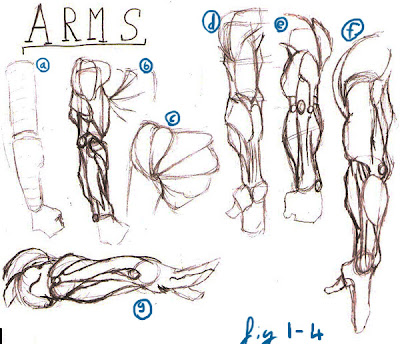
Sunday, 5 February 2012
Saturday, 4 February 2012
Friday, 3 February 2012
Research - David Finch Dynamic Figure Drawing Body -04
The purpose of this test is to understand the positioning of the muscles in the leg and how it attaches to the rest of the body.

Again starting with the large shapes as a base as in image [a] then structuring the muscles on the front and back on the leg as in image [b] and [c] This is also a good example of the previous point about the muscles being shapes like inter-connecting footballs as they are more apparent in the leg as the muscles are larger and longer. A good example of line flow is in image [d].
When drawing the legs David points out how similar the the muscles in the upper leg are to the muscles in the arm but reversed as in Image [d]. He also describes the body as an engine where different parts are similar in design but retro fitted for different purposes e.g arms and legs. this is shown in the images below ( Fig R-1 and Fig R-2 )

^^Fig R-1^^


^^Fig R-2^^
Fig R-1 from http://spot.pcc.edu/~lkidoguc/Topics/muscles.htm
Fig R-2 from http://www.aidmypain.com/meniscus/information.php
Wednesday, 1 February 2012
Research - David Finch Dynamic Figure Drawing Body -03
The purpose of this test is to gain a better understanding of the positions of the muscles in the arm and how they attach to the shoulder.

The above images use the aforementioned tube-form technique (see image [a]) as a base. David Finch doesn't know the names of all the muscles in the body and builds the muscles in relation to each other creating flow through a figure as in image [b]. The chest and shoulder muscles that attach the arm to the body start at the same place and fa
n-out as in image [c]. David describes the muscles as inter-connecting footballs (American footballs) demonstrated buy image [d]. Once an understanding of where the muscle shapes are in relation to each other was achieved the tutorial continues by rotating the arm so the muscle shapes can be seen from different views. The circles in image [e] represent where the tendons attach the muscle to the bone in image [e] the three bones of the elbow are visible as is the protruding bone in the wrist. Image [f] shows the muscle flow from the side and image [g] shows the arm raised from the side of the body.

^^Screenshot from DVD^^
Strengths
The advantages of the tube-form under-sketch are apparent in these images by using the larger shapes to get the proportions correct then breaking them down into smaller detailed muscle shapes. The technique of drawing the muscles in relation to each other and not drawing each one individually which can cause the muscles to look disconnected, By drawing them in relation to each other creates flow and makes the muscles look connected rather than floating.
Weaknesses
Research - David Finch Dynamic Figure Drawing Body -02 pt2
The goal of this test is to use the tube-form characters and develop them into perspective.

Now that the body has been broken down into basic shapes it makes it easier to angle them in perspective for example above in image [a] and [b] it is easy to make the tube-form character fit the construction or perspective lines. However its not as simple as drawing a cylinder in perspective as the body isn't made up of flat shapes, so when foreshortening accentuate the body's natural curves as shown in above image [c] on the right leg whereas the left leg looks less dynamic. Also anything closer to the foreground becomes longer and anything further away becomes shorter.
 The above image [a] and [b] shows more tests carried out on perspective and the tube-form shape images [c] and [d] however show the basic block shapes for drawing an arm and how to add more simple shapes to get an idea of the location of the muscles.
The above image [a] and [b] shows more tests carried out on perspective and the tube-form shape images [c] and [d] however show the basic block shapes for drawing an arm and how to add more simple shapes to get an idea of the location of the muscles.Strengths
The strengths of this technique are that with little knowledge of anatomy at all, an artist can pose this tube-form character in many different positions and decide whether or not to continue. Without spending a large amount of time on the details the artist is free do do many different poses and still meet a deadline as no time was wasted refining the wrong pose.
Weaknesses
The weaknesses of this technique are that without a good knowledge of the placement of muscles the tube-form character can show through a design making a character look block-like and unbelievable.
This is a useful under-sketch technique which can be carried through into subsequent designs however a more advanced knowledge of muscle placement is needed to make designs believable and realistic.
Subscribe to:
Comments (Atom)













